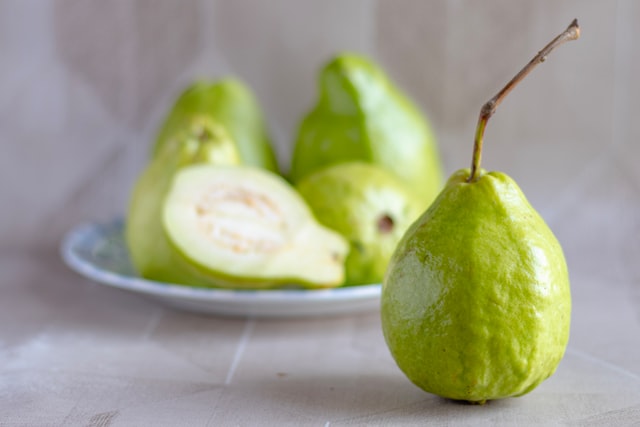What is guava
The exact name of the species of fruit plants to which the guava is assigned is “Psidium Guava”. According to archaeological data, it exists and has been cultivated on Earth for at least several thousand years. Peru is considered the birthplace of an exotic tree.
The guava fruit is a round, pear-shaped, or oval fruit with yellowish-white, bright yellow, green or reddish skin. Its dimensions can vary from 4-15 cm in diameter.
guava is cut like a small tomato. Its flesh is filled with small hard seeds and can be white, yellow, pink, or red. Ripe guava has a pleasant, and sometimes the rather strong smell of musk, and it tastes like raspberries, papaya, and a little melon at once.
Is there a difference between guava and guava
Guava (guava, guava, guayaba) is a plant and product with a long history. It was first mentioned by the Spanish priest and geographer Pedro Cieza de Leon in his book Chronicle of Peru back in 1553. An excerpt from his treatise reads as follows: “In addition, there are pineapples, guavas, guavas (inga), guanabana (Annona), avocados, and several types of currants that have a delicious peel …”.
And although the traveler in his notes lists fruits as independent, in fact, guava and guava are two names for the same plant, the only difference is in the pronunciation of its Latin name in different languages.
Where and how does the fruit grow
In nature, guava trees can be found in all tropical regions of the planet, they also grow in some subtropical areas of Asia, Africa and America. Usually their height does not exceed 3-4 meters, but some specimens grow up to 20 meters up.
The guava tree is an evergreen or semi-deciduous tree with spreading branches and large oval dark green leaves. The plant blooms 1-2 times a year: medium-sized single very fragrant flowers with white or greenish petals and numerous long stamens bloom in the axils of the leaves. Later, in their place, fruits appear that look like berries, with a thin, bumpy skin and loose, sweet pulp.

Chemical composition, nutritional value, calorie content
Guava fruit not only tastes good and looks exotic, in addition, it also has a rich biochemical composition. The “berries” of this tropical plant contain:
- vitamins: A, C, K, group B, tocopherols, nicotinic acid, etc.;
- minerals: potassium, calcium, copper, phosphorus, zinc, manganese, selenium, etc.;
- essential oils, flavonoids, tannins;
- fruit acids;
- fiber and pectin.
Nutritional value of fruits:
- proteins – 2.6 g,
- fats – 1 g,
- carbohydrates – 14.3 g,
- water – 80.8 g.
The calorie content of ripe guava is 68 calories per 100 g of pulp.
Useful properties of fruit
Due to its rich composition, guava is very beneficial for human health. Its medicinal properties are well known and widely used in oriental medicine. Among them are the following features of the plant:
- the fruit is used to normalize digestion: it helps to gently remove toxins and toxins from the body, can stop indigestion and intestines, and has a beneficial effect on metabolic processes in the body;
- the fruits contain substances that help to cure cough that accompanies diseases of the upper respiratory tract;
- Guava is useful for type 2 diabetes. Its fruits contain lycopene, a substance that helps the body maintain normal blood sugar levels. The glycemic index of guava is 25 units, although this is a low indicator, the fruit still contains sugars of natural origin, so people with diabetes should consult a doctor before including it in the diet (especially for type 1 disease);
- guava leaves also have healing properties: teas and decoctions are prepared from them to strengthen immunity, restore liver health, lose weight, lower blood cholesterol levels, etc .;
- the medicinal properties of the leaves are also used to disinfect and accelerate the healing of open and festering wounds;
- the essential oil of the fruit has a powerful antimicrobial effect – it is used in aromatherapy and in the treatment of viral diseases.

